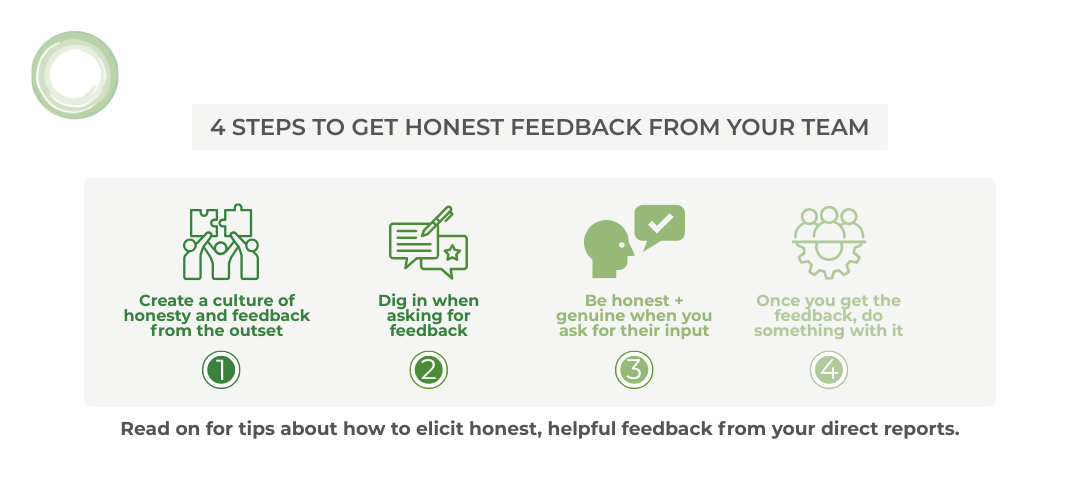Do you think you can get your team to give you honest feedback? Like no-holds-barred honest?
Many of my clients tell me they struggle to get real feedback from their direct reports and I’m not surprised.
Does this story sound familiar? One of my senior clients recently received the results of his 360 report and was surprised to learn that his team felt they weren’t being mentored effectively by him.
None too pleased with this, he walked out into the office and proceeded to go desk to desk. “Was this comment from you? Do YOU think I’m a good mentor? Do you have a problem with the way I mentor?”
Unsurprisingly, pretty much everyone told him that no, no, everything was fine, and THEY weren’t the ones who had taken issue with his mentorship style.
The result of all this?
- The team members felt even less inclined to be honest about their concerns in the future.
- The CMO thought he didn’t need to change anything because he’d terrified his staff into telling him what he wanted to hear.
- The mentoring problem remained unsolved.
Struggling with how to interpret and act on feedback like a 360 report? Our executive coaching helps leaders turn tough feedback into transformational growth.
Now granted, this is a more extreme case. However, even well-meaning CEOs have trouble getting honest feedback because it feels uncomfortable to tell our boss what we really think when they hold power over the purse strings.
I don’t want this to happen to you or your team! Read on for tips about how to elicit honest, helpful feedback from your direct reports.
4 Steps to Get Honest Feedback from Your Team
1) Create a culture of honesty and feedback from the outset
It shouldn’t feel wildly out of character for you to ask for honest employee feedback. When you ask your team to take part in a 360 assessment, it shouldn’t be the first time you’ve ever elicited their input.
When we make space for frequent feedback in our company culture, our direct reports know we value them and their opinions.
How often are you asking for feedback? Twice a year? Once a month? Once a week? How will you know how effectively you are leading your team if you don’t ask how you are impacting them? I’ve seen it work really well for a boss to ask for feedback in 1:1 direct report meetings about once a month. And this can start small! Ask them how they feel about the donuts that are served in meetings, the desk chairs they’re using, or the holiday party DJ.
But, of course, move on from there to questions you have about your leadership and their experience of the company:
- What’s your favorite thing about coming to work at our company?
- What aspects make you want to stay in bed and hit the snooze button?
- If you could change one thing about our culture, what would it be?
- How effective are the team meetings I facilitate? What could I do to make them more effective?
- Who’s the best boss you have ever worked for before coming to work on our team? Why? What suggestions do you have for me based on your experience with them?
You get the idea (or for more ideas, see this post on retaining your best employees). If you start by asking them for feedback on small things and they see you making changes based on their feedback — like swapping bagels for donuts — they’re much more likely to give you honest feedback about the big stuff.
2) Dig in when asking for feedback
The first few times you ask your direct reports for feedback, you might get a lukewarm “everything’s fine, whatever you think is best” style response.
When you truly want your team’s feedback on something — keep asking them for it. It might take multiple requests and multiple months, but if you continue asking, you’ll eventually get some helpful answers because you are showing you are tenacious and really serious about getting feedback.
Not getting traction with your team’s feedback loops? Take our EDGE assessment to understand how your leadership style is perceived — and how to better connect.
3) Be honest + genuine when you ask for their input
Tell them why you want this feedback in the first place and what you hope to do with it. Explain your goals as a leader and how their feedback can help you, the team, and the whole company.
Many direct reports view 360 Feedback Surveys as a necessary evil mandated by HR, a space to write a few milquetoast criticisms that will never be addressed. But if your team understands how impactful their feedback can be and how important it is that they’re forthcoming, they’re more likely to be honest about where there are opportunities for growth.
4) Once you get the feedback, do something with it
First and foremost, thank everyone who took the time to give you feedback — regardless of whether that feedback was positive or negative. Make sure they know that they’ve helped both you and the company by being honest.
Most importantly, do something with the feedback they’ve mustered the courage to give you. If several people mentioned that your meetings run too long, figure out how you can make them shorter. If some people wished you phrased your criticism more diplomatically, work with a leadership development coach to strengthen that skill.
And make sure your team realizes that you’re making these changes because of their feedback. Awkward as it may sound, you might have to specifically point out that you’re making a change based on their input.
Next time you send out a meeting invite, you could add a line that says “No, your eyes do not deceive you! This meeting is, in fact, only 20 minutes. It seems everybody prefers shorter meetings — I appreciate that feedback!”

Do you need help getting honest feedback from your team? We’d love to help you create an environment where that can happen. Click here to learn more about how we can help.


